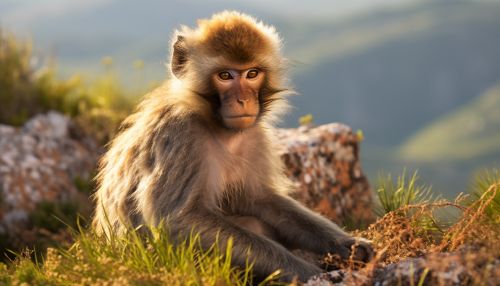Macaca sylvanus
Taxonomy and Evolution
The Macaca sylvanus, commonly known as the Barbary macaque or Barbary ape, is a species of macaque unique to North Africa. It is one of the best-known Old World monkey species and the only macaque species found outside of Asia. Despite the name, the Barbary macaque is not a true ape, but a monkey. The term "ape" in the name is due to its lack of a tail, a feature often associated with apes.


The Barbary macaque belongs to the genus Macaca, which comprises 23 species of macaques. The genus is part of the larger primate family Cercopithecidae, also known as the Old World monkeys. The Barbary macaque's closest relatives are the Asian macaques, including the rhesus macaque (Macaca mulatta) and the long-tailed macaque (Macaca fascicularis).
The Barbary macaque's evolutionary history is not well understood due to a lack of fossil evidence. However, it is believed that the species diverged from its Asian relatives around 5.5 million years ago, during the Miocene epoch. The species' unique distribution in North Africa is thought to be the result of ancient human activities, such as trade and transportation.
Description and Anatomy
The Barbary macaque is a medium-sized monkey with a body length of 45 to 75 cm (18 to 30 in) and a weight of 7 to 13 kg (15 to 29 lb) in males and 5 to 9 kg (11 to 20 lb) in females. Unlike other macaques, the Barbary macaque lacks a tail, giving it an appearance more akin to apes. This tailless feature is a primary reason for its common name, the Barbary "ape".
The species has a dense coat of fur, which is multicolored and ranges from a yellowish-brown to grey. The face is pink and hairless, with prominent brow ridges and a short muzzle, typical of the Macaca genus. The Barbary macaque has a dental formula of 2.1.2.3, similar to other Old World monkeys, with large, well-developed canines, particularly in males.
The Barbary macaque has several adaptations to its cold mountainous environment. It has a large, barrel-shaped body and a thick fur coat to retain heat. Its hands and feet are broad and padded, aiding in locomotion across rocky terrain.
Distribution and Habitat
The Barbary macaque is native to the Atlas and Rif Mountain ranges of Algeria, Morocco, and Tunisia in North Africa. It is the only macaque species found outside of Asia and the only primate species, apart from humans, in Africa that lives north of the Sahara.
The species prefers mountainous regions covered in cedar, pine, and oak forests. It can also be found in scrub and rocky areas when forests are not available. The Barbary macaque can live in a variety of altitudes, from sea level up to 2,100 meters (6,900 ft).
The Barbary macaque has also been introduced to the Rock of Gibraltar, where it is one of the top tourist attractions. The population in Gibraltar is the only wild monkey population in Europe.
Behavior and Ecology
Barbary macaques are diurnal and spend their day foraging for food, grooming each other, and playing. They are primarily terrestrial but can climb trees to find food or avoid predators. The species is known for its unusual social structure and behavior. Unlike most primates, males play a significant role in rearing young, a behavior known as allocare.
The diet of the Barbary macaque consists mainly of plants and invertebrates, including leaves, roots, and insects. During the fall, the species will also eat fruits and seeds. The Barbary macaque plays a crucial role in its ecosystem by dispersing seeds through its feces.
The species has a polygynandrous mating system, where both males and females have multiple mating partners. Females give birth to a single offspring after a gestation period of about 147 to 192 days.
Conservation Status
The Barbary macaque is currently listed as Endangered on the IUCN Red List due to habitat loss and illegal pet trade. The species' population has declined by more than 50% over the past 30 years. Conservation efforts are focused on habitat preservation and public education about the species' ecological role and legal protection.
